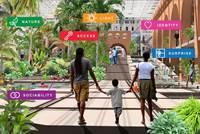Designing Happiness: Capitalizing on Nature’s Restorative Qualities

This research leaps from the science of happiness found in a literature review to design strategies for universal application in architectural, planning, and urban design practice. It then applies those strategies to a virtual test case set in Baltimore City.
• Design Strategy: Amplify Biodiversity
• Design Strategy: Integrate Water
• Design Strategy: Encourage Positive Social Interaction
• Design Strategy: Strive for Beautiful Surprises
• Design Strategy: Use Sunlight as a Source of Well-Being
• Design Strategy: Capitalize on Community Priorities
• Design Strategy: Ensure Access to All
This paper extracts insights on the impacts of social interaction, access, surprise, light, and beauty on happiness then extrapolates design principles and strategies to use in creating built environments that promote greater well-being. A virtual test case, drawn from a Master of Architecture thesis, is used to demonstrate possible ways these selected principles and design strategies can connect people to nature, with the intent to inform a science-backed approach to creating truly happy places. It is anticipated that these tactics will be useful to architects, planners, and urban designers as they endeavor to design positive user experience into form and place.
KEYWORDS: Nature, Access, Happiness, Design


Add comment
Log in to post comments